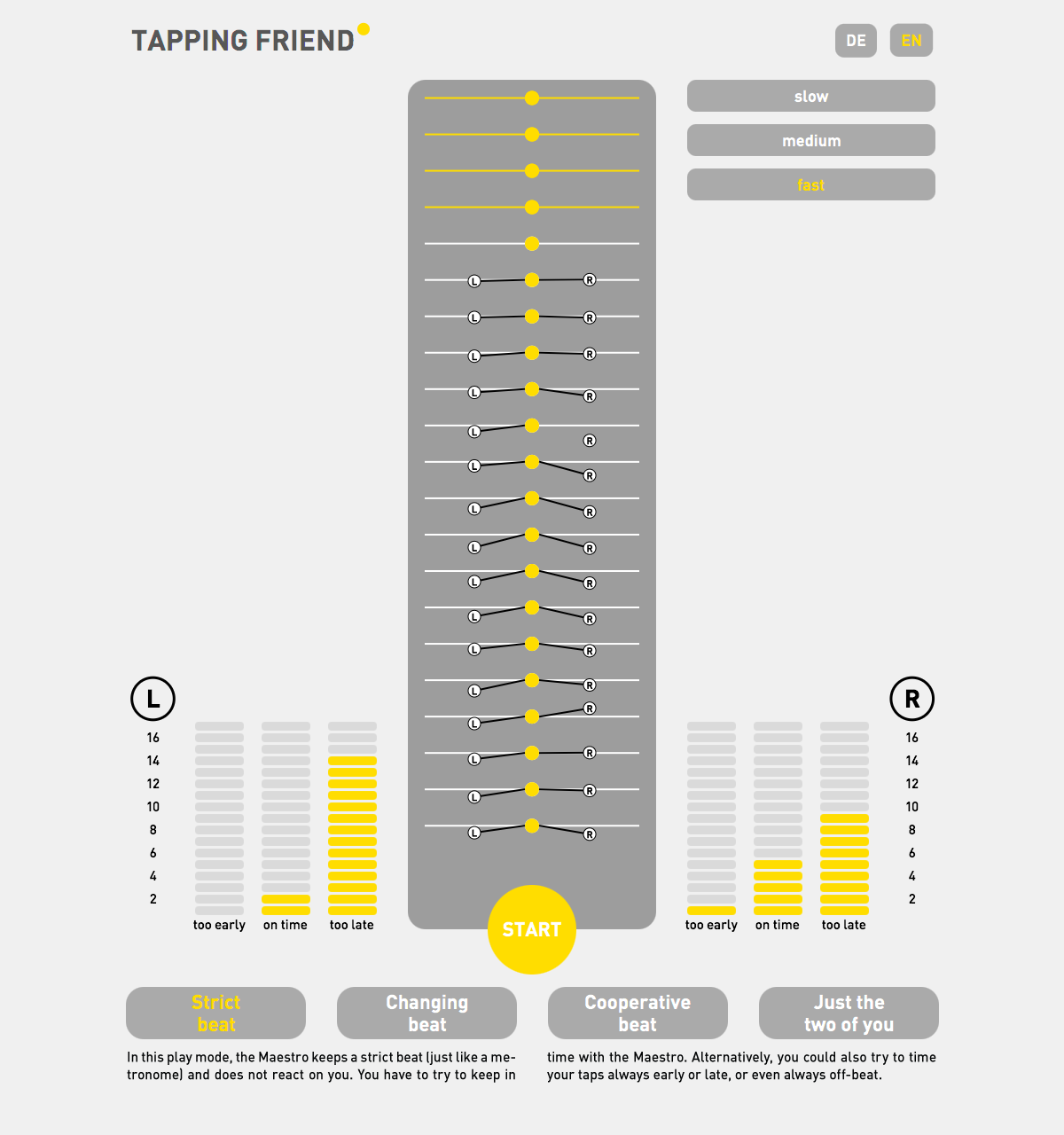Projects
2012 – 2016
INSYNC
Synchronization and Communication in Music Ensembles
Interpersonal communication and the coordination and synchronization of actions are fundamental human capacities. People use these functions routinely in activities such as shaking hands, driving a car, playing sports, or playing music as part of an ensemble. To coordinate your actions with someone else’s, you must be able to predict how the other person is going to behave. Music ensemble performance provides a particularly interesting context for studying prediction and coordination because the synchronization between actions must be so precise. Since music is dynamic, or time-varying, ensemble musicians must make predictions about their co-performers’ behaviour as they play, relying primarily on nonverbal cues provided by their co-performers’ body movements, breathing, and sound. This research project investigates the mechanisms underlying musical synchronization in small ensembles, using a combination of perceptual/performance experiments and computational modelling techniques.
2013 – 2016
Lrn2Cre8
Learning to Create
Lrn2Cre8 aims to understand the relationship between learning and creativity by means of practical engineering, theoretical study, and cognitive comparison. We begin from the position that creativity is a function of memory, that generates new structures based on memorised ones, by processes which are essentially statistical.
2013 – 2016
PHENICX
Performances as Highly Enriched aNd Interactive Concert eXperiences
Modern digital multimedia and internet technology have radically changed the ways people find entertainment and discover new interests online, seemingly without any physical or social barriers. Such new access paradigms are in sharp contrast with the traditional means of entertainment. An illustrative example of this is live music concert performances that are largely being attended by dedicated audiences only. The PHENICX project aims at bridging the gap between the online and offline entertainment worlds. It will make use of the state-of-the-art digital multimedia and internet technology to make the traditional concert experiences rich and universally accessible: concerts will become multimodal, multi-perspective and multilayer digital artefacts that can be easily explored, customized, personalized, (re)enjoyed and shared among the users.
2014 – 2015
ACCIA
Automated Coding and Categorizing of Innovation Areas
Generelles Ziel des Projekts „Automated Coding and Categorizing of Innovation Areas“ (ACCIA) war es, ein intelligentes automatisiertes System zu schaffen, das Belegstellen für problembezogene, innovationsrelevante Äußerungen, welche aus unterschiedlichen Online-Quellen extrahiert wurden, identifizieren, analysieren und kategorisieren kann. Durch die Einbindung von Verfahren aus den Bereichen Textverarbeitung, Document Clustering und Document Classification konnte ein Prozessmodell erarbeitet werden, dass eine bisher rein manuell durchgeführte Innovationsfeldanalyse in ein automatisiertes Modell überführt, in dem die manuelle, expertinnengetriebene Analyse mit automatischen, computerlinguistisch gestützten Verfahren verschränkt wird.
2014 – 2015
PotenziAAL
Potential and Limits of Present-day Robotics in Ambient Assisted Living
The central aim of the study is the realistic presentation of the potential of AAL Robotics, based on the analysis of parameters drawn from user needs, technical readiness, and existing business models. Instead of compiling yet another collection of individual solutions and projects, the PotenziAAL Study will aggregate existing knowledge gained from analysis of secondary sources with knowledge generated from primary sources such as expert interviews, a workshop and user focus groups in order to achieve a comprehensive picture of the state of the art in AAL Robotics and its future potential. The study will develop categories and criteria in order to foster exact characterization, comparability and quality assurance in AAL Robotics.
2014 – 2015
Cognitive-emotive Robotics for Supporting Autobiographic Storytelling
The aim of the project is the development of a virtual agent that interactively supports older persons in the narration of autobiographic stories, from listener feedback to raw transcription.
2015
Tapping Friend
An interactive exhibit on synchronization and cooperation between humans and a virtual partner
TAPPING FRIEND is an interactive science game for everyone between 6 and 99 years and is aimed to provide a playful experience of synchronization and cooperation between one or two humans and a virtual partner – the maestro. The players tap in time with the maestro on little drums and the system provides immediate feedback on their synchronization success by showing their taps relative to the maestro’s taps and by counting the taps that were on time and the taps that were too early or too late. The aim of the game is to achieve as many on-time taps as possible.
2012 – 2014
FemSMA
Automated, gender-sensitive approaches as a means to support social media analyses in Social Sciences reseach.
The FemSMA project aims at the development of automatic methods to determine the gender of the author of a given user-created social media posting (e.g. Tweets, blog or internet forum entries). The approach is motivated by recent developments in the social sciences, as well as market and opinion research, which increasingly consider social media platforms as a valuable source of data, especially for trend and sentiment analyses. Current instruments for social media analysis are incapable of providing gender-aware information regarding the topics, products or (political) programmes under investigation. This deficit, as well as the associated lack of orientation towards active demand, will be countered effectively in FemSMA.
2012 – 2014
Preventing Hubness in Music Information Retrieval
he so-called “hubness” phenomenon is a general problem of machine learning in high dimensional data spaces. Hubs are data points which keep appearing unwontedly often in nearest neighbor lists of many other data points. This effect is particularly problematic in algorithms for similarity search, as the same “similar” objects are found over and over again. But it has also adverse effects for the many machine learning algorithms that make use of distance information. The effect has been shown to be a natural consequence of high dimensionality and as such is yet another aspect of the curse of dimensionality. The main goal of this project was to conduct an in-depth study of the hubness problem in the context of MIR.

